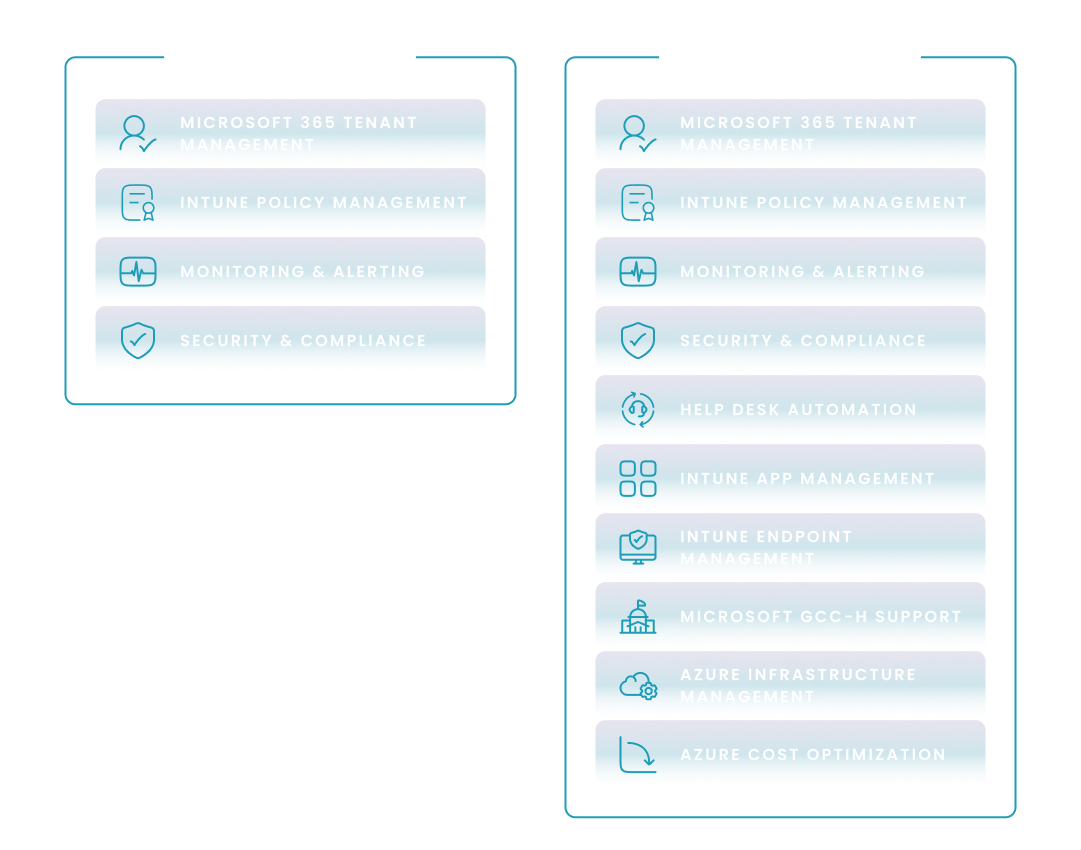How do you scale Intune management beyond policy administration?
For modern MSPs, Microsoft Intune is the foundation of endpoint security and management. However, relying on it alone creates significant challenges in cost control, security hardening, and operational efficiency when managing multiple clients at scale. The solution isn't to replace Intune, but to build a management layer on top of it. Different platforms solve different parts of this challenge.
This table breaks down the key differences in how each type of platform builds upon Intune's core capabilities.
| Intune Capability |
Inforcer
(Focused Microsoft 365 Platform) |
Nerdio
(Unified Cloud Platform) |
| Security Approach |
Policy Enforcement: Excels at deploying Intune security baselines and monitoring for configuration drift across tenants. |
Image-Level Hardening: Deploys desktops from pre-hardened images, ensuring security is built-in before policies are even applied. |
| Endpoint Policy & Enrollment |
Specialized Policy Management: Offers granular tools for managing Microsoft 365/Intune policy rules, baselines, and backups. |
Solving Intune's Gaps: Focuses on solving common Intune challenges at scale, such as policy conflicts, compliance visibility, and data retention. |
| Operational Scope |
Microsoft 365-Centric: Manages Intune policies within the context of the Microsoft 365 environment. |
Holistic VDI Management: Manages both AVD and Windows 365 from a single console, streamlining operations for mixed environments. |
How do you move from policy enforcement to comprehensive security hardening?
Ensuring consistent security is a top priority. Platforms focused on Microsoft 365 administration, like Inforcer, excel at the policy layer. They provide powerful tools to deploy standardized Intune security baselines, monitor for configuration drift across tenants, and prepare clients for advanced tools like Microsoft Security Copilot. This is critical for maintaining a consistent policy posture.
However, a unified platform like Nerdio complements this by offering more robust controls at the user, group, application, and most importantly the device level, which tools like Inforcer do not address. Consolidated solutions like Nerdio excel at addressing security at the image level. Instead of just enforcing policies after a device is deployed, Nerdio allows you to deploy Cloud PCs and virtual desktops using pre-configured, security-hardened images. This ensures that hundreds of security settings are correctly configured before the user ever logs in, dramatically reducing the attack surface and guaranteeing a higher level of standardization from the very start.
How do you solve Intune's operational gaps at scale?
A crucial capability gap with native Intune is the lack of tools to address common, time-consuming operational challenges across multiple tenants. While you can manage device policies, it's difficult to solve issues like policy conflicts or provide secure remote support efficiently.
This is a critical area where a unified platform provides value by acting as a management and automation layer on top of Intune. Nerdio, for example, helps proactively detect and surface policy drift and conflicts. This allows your team to resolve issues before they cause user downtime, rather than troubleshooting after the fact.
How do you streamline support and compliance across the endpoint estate?
Your clients’ endpoint environments—including both physical and virtual desktops—are all enrolled and managed in Intune. This creates operational complexity for technicians who need to provide support and for compliance teams who need to prove historical adherence to policy.
A unified platform provides a centralized management console to streamline these functions. It can provide Level 1 help desk technicians with secure, direct remote access to endpoints via tools like Nerdio Console Connect, reducing escalations that consume senior engineer time. Furthermore, it solves the compliance data retention problem by providing long-term historical reporting that extends far beyond Intune's 30-day limit, allowing your team to generate audit evidence in minutes, not weeks.




